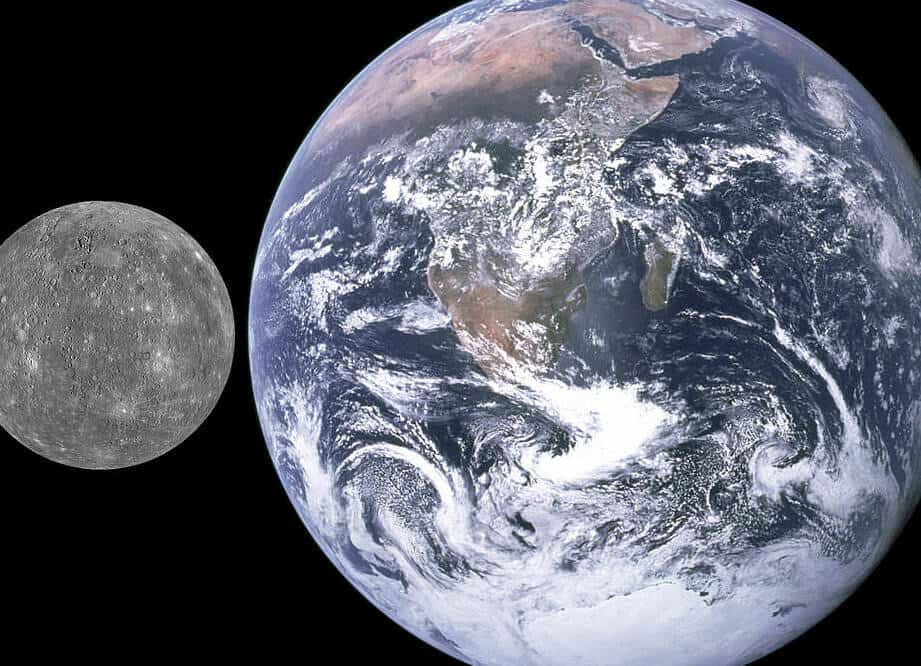
Mercury is the smallest planet in the solar system and it is also the closest planet to the Sun. Its diameter is much smaller than the diameter of the Earth. Mercury was named after the ancient Greek god of commerce, who was well-known for his incredible speed. The planet also orbits around the Sun at a very fast pace, completing a full revolution in just 88 days. In comparison, it takes the Earth 365 days to complete a full revolution around the Sun, which is equivalent to one year. This means that a year on Mercury is shorter than three months on Earth!
Evidently, in ancient times, there was awareness of Mercury. The luminous “star” observed in the morning was referred to as Apollo by the Greeks and Hermes in the evening. It is believed that scientists even hypothesized that it was the same celestial body. However, despite this, until the late 19th century, there was limited knowledge about this diminutive planet. The situation became more comprehensible only after the Mariner 10 spacecraft embarked on a mission to Mercury in 1973.
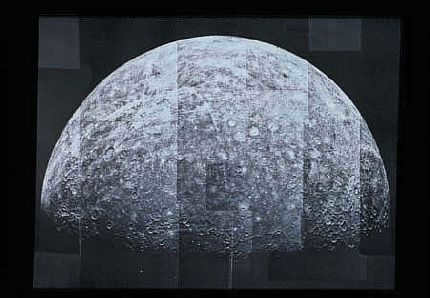
The planet Mercury is located so close to the Sun that it is not easily visible to the naked eye. It wasn’t until 1974 when the Mariner spacecraft flew past Mercury that astronomers were able to obtain a clear image of it.
Mercury follows an elliptical orbit around the Sun, with its maximum distance from the Sun being 70 million kilometers and its minimum distance being 46 million kilometers. The side of Mercury that is illuminated by the Sun’s rays can be observed from the Earth’s surface during the early morning or late evening, appearing above the horizon line.
Mercury possesses a remarkably thin atmosphere that provides minimal shielding against the scorching radiation of the sun and incoming celestial objects. Additionally, due to its slow rotation, there exists a significant disparity in temperature across the planet. The side facing the Sun can reach a sweltering +427 ° C, while the opposite side experiences a chilling -173 ° C.
Mercury contains water in the form of ice, which accumulates on the planet’s surface through collisions with comets and meteorites. Upon exposure to the intense heat on the sunlit side, the ice rapidly evaporates. However, on the shadowed side of the planet, it undergoes a phase change and solidifies, ultimately settling within deep craters.
A world filled with craters
Craters are depressions created on the outer layer of a celestial object due to the impact of another object from space. Mercury’s entire surface is adorned with craters, much like the moon’s surface. These craters were formed as a result of countless collisions with asteroids and comets, which the planet’s delicate atmosphere failed to shield against.
Comparison of Earth and Mercury
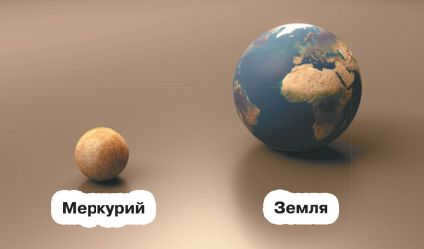
Is it possible for a day to be longer than a year? The answer is yes, but not on Earth. This phenomenon occurs on the planet Mercury. While Earth completes one rotation around its axis in 24 hours, which is equivalent to one day, Mercury rotates at a much slower pace. It takes Mercury 176 Earth days to complete one full rotation. In the same amount of time, Mercury manages to orbit around the Sun twice. Therefore, the duration between two consecutive sunrises on Mercury is exactly two Earth years.
Key characteristics of Mercury:
– Surface area: 7.5-107 km²
– Average distance from the Sun: 57,909,176 km
– Average orbital velocity: 47.36 km/s
– Orbital circumference: 360,000,000 km
– Orbital period around its axis: 58.65 Earth days
– Orbital period: 88 Earth days
Composition of Mercury’s atmosphere:

1) The density of Mercury is approximately the same as that of Earth, but its mass is 18 times smaller.
Find the ratio of the orbital period of a satellite circling around Mercury in a low circular orbit to the orbital period of a similar satellite around Earth.
2) A planet has a radius that is 2 times smaller than Earth’s radius.
It is known that the acceleration due to gravity on the surface of this planet is the same as on Earth.
What is the ratio of the mass of this planet to the mass of Earth?

The planet Mercury has a radius of 2,420 km and an acceleration of free fall of 3.72 m/s?
The planet Mercury has a radius of 2,420 km and an acceleration of free fall of 3.72 m/s.
Determine the mass of the planet Mercury.

Assistance Required
Could you lend me a hand?
Calculate the gravitational pull between Earth and Jupiter, as well as between Earth and Mercury.

What is the radius of the planet Mercury and what is the acceleration of free fall on its surface?
The planet Mercury has an average radius of 2420km and a free fall acceleration of 3.72m/s2 at its surface.

Which planet has less gravity – Earth or Mercury?
Which planet has less gravitational force – Earth or Mercury?
What is the value of gravitational acceleration on Mercury?

Is the density of Mercury similar to that of Earth, even though its radius is 2.63 times smaller?
Mercury’s density is approximately the same as Earth’s density, but its radius is 2.63 times smaller.
Calculate the ratio of the first escape velocity on Mercury to the first escape velocity on Earth.
1) 0.38 2) 1.62 3) 2.63 4) 6.92.

Good day?
Assist me in resolving this issue: Determine the initial escape velocity for the planet Mercury.
The mean density of Mercury is 5.43 grams per cubic centimeter, and the radius of Mercury is 2440 kilometers. I appreciate your help.

Do you need assistance?
Calculate the gravitational force between Earth and Jupiter, as well as between Earth and Mercury.
What is the ratio of Mercury’s mass to Jupiter’s mass?
Find out how many times Mercury’s mass is smaller than Jupiter’s mass.

What is the average radius of Mercury and what is the acceleration due to gravity on this planet?
What is the average radius of Mercury, which is approximately 2420km, and what is the acceleration due to gravity on this planet, which is about 3.72m/s?
Here you can find the solution to the query “What is the ratio of the size of Earth to that of Mercury?”. Additionally, you can explore other related topics in the field of Physics by utilizing the user-friendly search engine provided. The complexity of the question is suitable for students ranging from 5th to 9th grade. Feel free to browse through the comments section below to read the responses from other visitors. Engage in online discussions with them regarding the subject matter. If none of the provided answers meet your satisfaction, feel free to create a new question using the search box located at the top of the page, and then simply click on the submit button.

It’s most likely going to be around 74 degrees.

The location of the cone in which constellation it is irrelevant. The force mg is exerted on the table from the lower base side, distributed over the area Sa. To convert the area to square meters, Sa = 4 cm² = 4 / 10000 m² = 0.0004 m². P = mg /.
For PERIOD, the weight will travel a distance equal to four amplitudes: L₀ = 4 * 3 = 12 cm or 0.12 m. Therefore, the number of oscillations is determined by: n = L / L₀ = 0.36 / 0.12 = 3. The answer is 3 oscillations.

The value of Q can be calculated by multiplying λ by m, which results in 4 times 330000, equaling 1320000J or 1320 kJ.

The equation for finding the mass is Q = m * λ. Therefore, we can calculate the mass by dividing Q by λ, which equals 0.1 kg or 100 grams of lead.

The velocity (V) is equal to 72 km/h, which is equivalent to 20 m/s. The acceleration (a) can be calculated using the formula a = V² / R, where R is the radius of the circle. In this case, a = 20² / 500 = 0.8 m/s². The net force (N) can be found using the formula N = m(g – a), where m is the mass and g is the acceleration due to gravity. For a mass of 500 kg and g = 10 m/s², N = 500×(10 – 0.8) = 4600 N (or 4500 N if we take g to be 9.8 m/s²).

0, 3 * m1 = N * 0, 2. 0, 1 * N = 0, 3 * M. m1 = 2M. M is equal to 1.2 kg.

Working with vectors is more challenging than working with projections because displacement, velocity, and acceleration are all vector quantities.

Answer: Explanation: Given: S₁ = S / 4V₁ = 72 km/h S₂ = 3-S / 4V₂ = 15 m/s ____________ Vcp -? The entire path is equal to S. Time on the first quarter of the path: t₁ = S₁ / V₁ = S / (72-4) = S / 288 h Time on the rest of the path: t₂ = S₂ / V₂ = 3-S / (15-4) = 3….
© 2000-2023. When using materials in whole or in part, reference is mandatory. 16+
The site is protected by reCAPTCHA technology, to which Google’s Privacy Policy and Terms of Use apply.
Ancient people believed that Mercury was the fastest moving planet, so they named it after the swift messenger of the gods. Further research revealed that this movement is due to Mercury’s close proximity to the Sun (Mercury is the first planet in the solar system).
However, the planet is also notable for its unique temperature characteristics. It must withstand extreme heat and icy cold simultaneously. This rocky planet has a very thin atmosphere. To truly appreciate its distinct features, let us now compare Mercury to Earth.
Dimensions, weight, and orbit
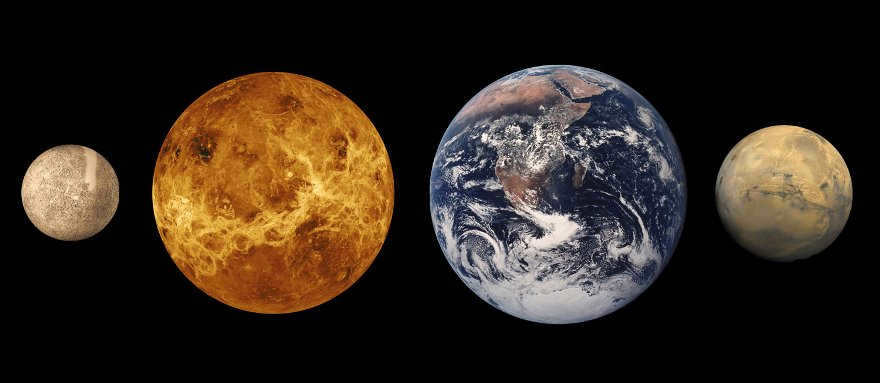
A comparison of the sizes of Mercury, Venus, Earth, and Mars
Mercury has a diameter of 4879 km, which is only 38% of Earth’s diameter. In other words, three Mercuries can fit within the size of our planet. The image below provides a visual representation of this size comparison, highlighting the significant difference between Earth and Mercury.
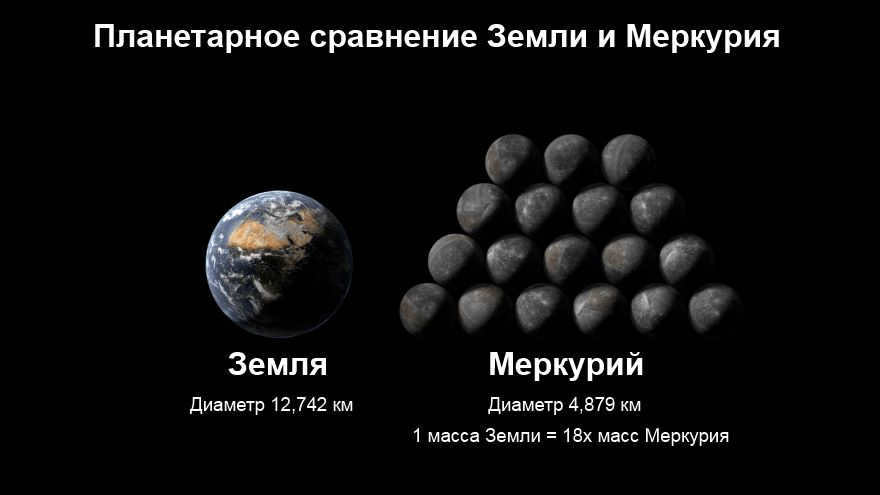
Comparing Earth and Mercury
Mercury has a mass of 3.3 x 10^23 kg (which is 5.5% of Earth’s mass) and is the second densest planet with a density of 5.427 g/cm^3. The surface gravity on Mercury is 3.7 m/s^2, which is 38% of Earth’s gravity. This means that if your weight is 100 kg on Earth, it would be only 38 kg on Mercury.
Mercury has an area of 75 million km^2, which is 10% of Earth’s total area. If you could turn the planet around, it would be twice the size of Asia. The volume of Mercury is 6.1 x 10^10 km^3, which is 5.4% of Earth’s volume. You could fit 18 Mercuries within Earth and still have some space left.
While it takes Earth 365.25 days to complete one orbit around the Sun, Mercury only takes 87.969 days.
Mercury has the unique characteristic of having a day that is twice as long as its year. While it takes the Sun only 176 days to complete a full pass across the sky, it takes Mercury a staggering 58,646 days for a single axial rotation. This makes Mercury’s day the longest in the solar system. Another interesting fact about Mercury is its axial tilt, which is only 0.027°. In comparison, Earth has an axial tilt of 23.439°, making Mercury’s tilt the smallest in the solar system.
Composition and structure
Mercury is composed of silicate minerals and metals, similar to Earth. However, unlike Earth which is mostly silicate, Mercury is 70% metallic.
The planet has a molten iron core, surrounded by a silicate mantle. In comparison, Earth has a thicker core and mantle, with measurements of 3478 km and 2800 km respectively, while Mercury’s measurements are 1800 km and 600 km. The crust of Mercury is also thinner, measuring only 100 km compared to Earth’s 100-300 km. Additionally, Mercury’s core makes up 42% of its total volume, whereas Earth’s core only makes up 17%. To get a better understanding of Mercury’s structure, refer to the diagram below.
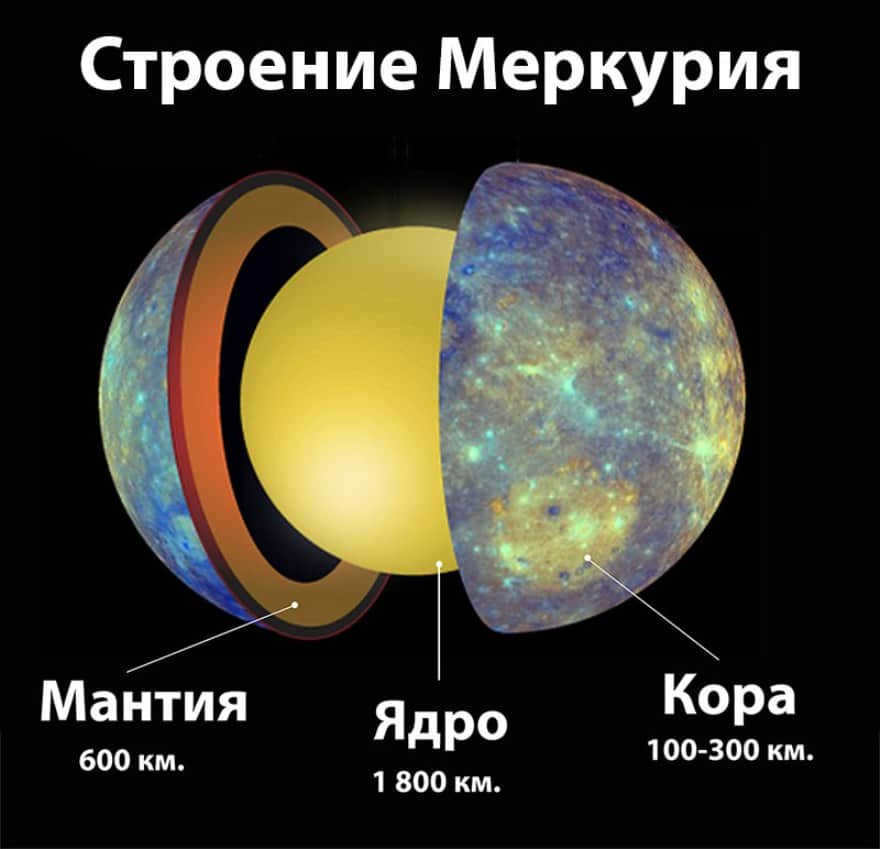
Mercury’s composition consists of a crust measuring 100-300 km in thickness, a mantle that extends 600 km, and a core with a diameter of 1800 km.
When comparing the surface of Mercury to the Moon, Earth’s natural satellite, similarities can be observed. Both celestial bodies exhibit a dry and barren landscape, characterized by numerous impact craters. These craters have remained unchanged for billions of years and serve as evidence of asteroid bombardment that occurred approximately 4.6 billion years ago. The size of these craters can vary significantly, ranging from minuscule to colossal in scale.
Among the many impact craters on Mercury’s surface, the largest is known as the Heat Plain, boasting a diameter of 1550 km. The force of the impact was so immense that it triggered volcanic activity on the opposite side of the planet, resulting in the formation of a 2 km high ring surrounding the crater.
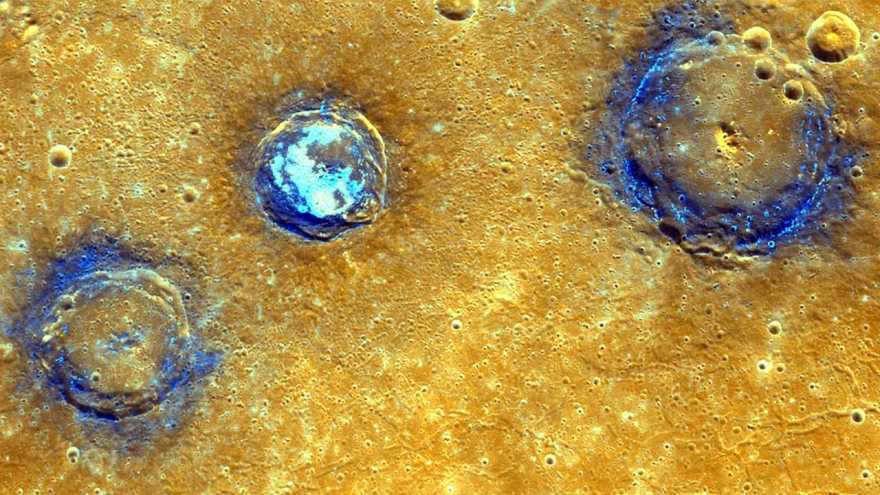
A closer view of the Munch, Sander, and Poe craters near the Heat Plain
The Earth’s surface is incredibly diverse. It is not only home to mountains and plains, but also vast continents surrounded by oceans. The planet boasts deserts, canyons, volcanoes, and plateaus.
Mercury, on the other hand, provides evidence of past activity. This is evident in the presence of narrow ridges that extend for hundreds of kilometers. These ridges are believed to have formed as the planet underwent a process of shrinking. However, while things may have calmed down on Mercury, Earth continues to be dynamic. Tectonic plates constantly shift, leading to periodic volcanic eruptions and earthquakes.
Atmosphere and temperature
When it comes to the atmosphere and temperature, these two planets couldn’t be more different. While Earth boasts a robust atmosphere with distinct layers and an abundant amount of nitrogen and oxygen, the same cannot be said for its counterpart.
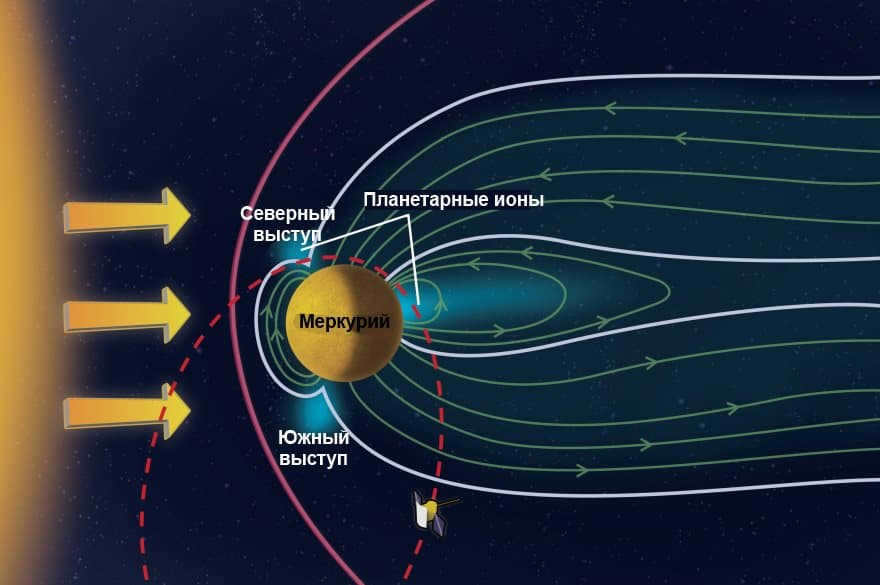

The MESSENGER spectrometer has successfully recorded the phenomenon of the solar wind pushing particles from the surface of Mercury into its thin atmosphere.
While Earth has an average temperature of 14°C, with a maximum of 70.7°C and a minimum of -89.2°C, Mercury’s thin exosphere is unable to retain heat. Additionally, the pressure on Mercury is only 10^-14 bar. As a result, the sunny side of the planet heats up to 427°C, while the temperature on the night side drops to -173°C.
Interestingly, despite these extreme temperature variations, water ice is still preserved at the poles of Mercury. This is because the ice is hidden in the depth of craters where direct sunlight cannot reach.
The core of Mercury generates a relatively feeble magnetic field, measuring just 1.1% of the Earth’s. The mechanism behind its formation is likely comparable to our own dynamo effect. Nevertheless, this magnetic field is sufficient to repel the solar wind and create a magnetosphere that captures the plasma from the wind, resulting in a gradual erosion of the planet’s surface into space.
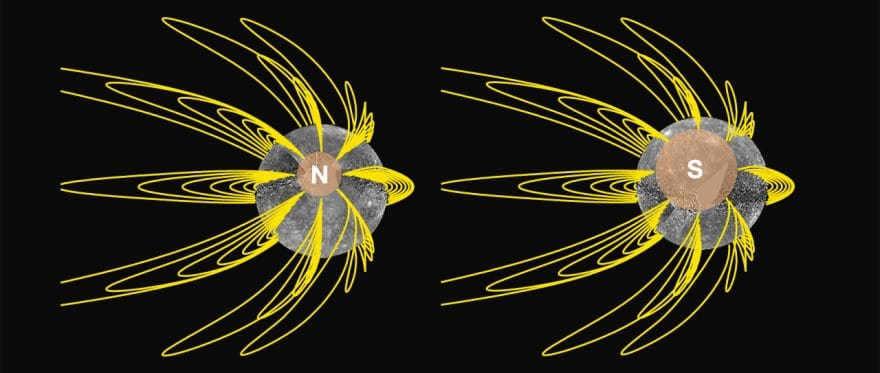
The structure of the magnetic field of Mercury
It is evident that there are several contradictions between Earth and Mercury. Despite being smaller and less massive, Mercury has a similar density to our planet. However, the extreme temperature conditions on Mercury make it impossible for a human mission to explore the planet. Nevertheless, there is still much more to learn about it.
Planet Mercury
Mercury is the initial planet from the sun and the tiniest planet in the solar system. It is one of the most extreme worlds. It got its name from a messenger of the Roman gods. It can be located without the application of instruments, so Mercury has left its impression in numerous cultures and legends.
Nevertheless, it is also an exceedingly enigmatic entity. Mercury can be viewed in the sky during the morning and evening, and the planet itself experiences its own phases.
Fascinating trivia
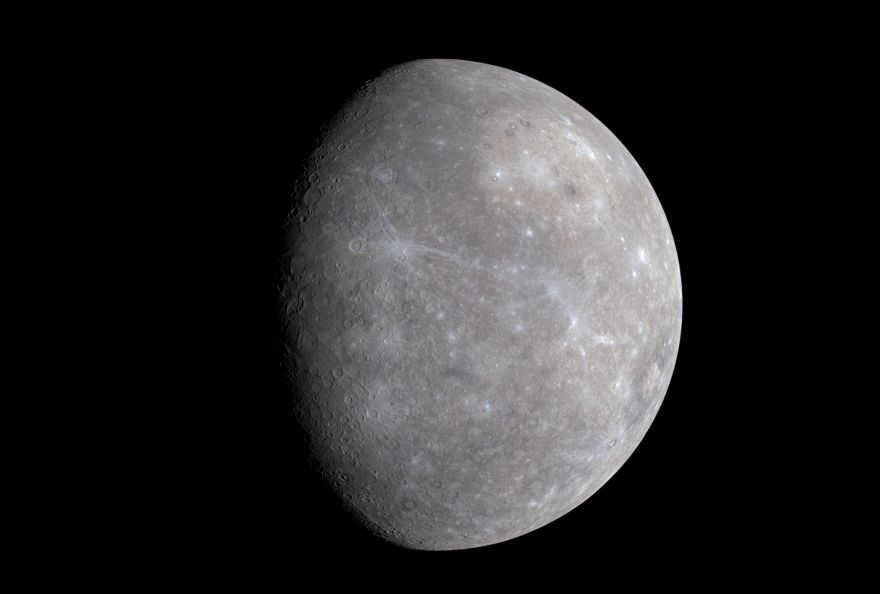
Let’s discover more fascinating information about the planet Mercury.
- Mercury has a solar day (midday interval) that lasts for 176 days, and a sideric day (axial rotation) that lasts for 59 days. It has the highest orbital eccentricity among all the planets, and its distance from the Sun ranges from 46-70 million kilometers.
- Mercury is one of the top five planets that can be observed without the need for instruments. It has a diameter of 4879 km at the equator.
- Each cubic centimeter of Mercury has a mass of 5.4 grams. However, Earth takes the lead as Mercury is predominantly composed of heavy metals and rocks.
- As the iron core of the planet cooled and contracted, the surface layer developed wrinkles that can stretch for hundreds of miles.
- Scientists speculate that the iron core of Mercury has the ability to remain in a molten state, which is unusual for smaller planets that typically cool down quickly. However, they now believe that the presence of sulfur in the core lowers its melting point. This core makes up 42% of the planet’s volume.
- Despite being further away from the sun, Venus consistently maintains the highest surface temperature due to the greenhouse effect. On Mercury, the temperature on the day side can reach up to 427°C, while dropping to -173°C on the night side. The lack of an atmospheric layer prevents an even distribution of heat on the planet.
- Geological processes play a crucial role in the rejuvenation of planetary surfaces and the smoothing of crater scars. However, Mercury lacks this regenerative capability. Interestingly, all of the craters on Mercury are named after renowned artists, writers, and musicians. Notably, impact formations that surpass 250 kilometers in diameter are referred to as basins, with the largest basin being the expansive Plain of Heat, stretching an impressive 1,550 kilometers.
- Due to its close proximity to the Sun, Mercury poses unique challenges for exploration. In fact, the Mariner 10 spacecraft orbited the planet three times between 1974 and 1975, successfully mapping just under half of its surface. Subsequently, in 2004, the MESSENGER spacecraft embarked on a mission to further explore this enigmatic planet.
- Interestingly, the exact date of Mercury’s discovery remains uncertain, as references to the planet can be traced back as far as the Sumerians in 3000 BC.
- Mercury’s gravitational force is only 38% of that on Earth, which is insufficient to sustain a stable atmosphere. The planet’s atmosphere is constantly being eroded by solar winds, causing gases to escape into space. However, this loss is compensated by the influx of solar particles and dust, which help replenish the atmosphere.
Size, mass, and orbit
Mercury is known as the smallest planet in the solar system, measuring just 2,440 km in radius and weighing 3.3022 x 10 23 kg. In terms of size, it is only 0.38 times smaller than Earth. While it may be smaller than some satellites, it holds the second highest density in the solar system after Earth, measuring at 5.427 g/cm 3. The photo below provides a visual comparison of the sizes of Mercury and Earth.

Comparison of Mercury and Earth
Mercury and Earth have some key differences. One notable difference is in their orbits. While Earth’s orbit is relatively stable, Mercury has the most eccentric orbit of any planet. This means that its distance from the Sun can vary significantly. At its closest point, called perihelion, Mercury is only 46 million km away from the Sun. However, at its farthest point, called aphelion, it can be as far as 70 million km from the Sun. This fluctuation in distance is unique to Mercury and sets it apart from the other planets in our solar system.
Another difference between Mercury and Earth is their average orbital velocity. Mercury’s average orbital velocity is – 47322 km/s, much faster than Earth’s. This high velocity contributes to Mercury’s shorter year. It takes Mercury only 87.969 days to complete one orbit around the Sun, compared to Earth’s 365.25 days. This means that Mercury experiences more frequent seasons and shorter years than Earth.
In conclusion, Mercury and Earth have distinct differences in their orbits and orbital velocities. These differences contribute to the unique characteristics of each planet.
Mercury’s Physical Characteristics
| 2439.7 km |
| 2439.7 km |
| 2439.7 km |
| 15,329.1 km |
| 7.48-10 7 km² 0.147 terrestrial |
| 6.083-10 10 km³ 0.056 terrestrial |
| 3.33-10 23 kg 0.055 terrestrial |
| 5.427 g/cm³ 0.984 terrestrial |
The eccentricity and slow rotation of Mercury cause the planet to take 176 days to complete one orbit around the Sun. As a result, one day on Mercury is twice as long as a year. Additionally, Mercury has the lowest axial tilt of any planet, measuring at just 0.027 degrees.
The Orbit and Rotation of Mercury
| 46,001,009 km 0.38709927 astronomical units |
| 69,817,445 km 0.46670079 astronomical units |
| 57,909,227 km 0.38709927 astronomical units |
Composition and surface
Mercury’s composition consists of 70% metallic and 30% silicate materials. It is estimated that the core of Mercury covers approximately 42% of the planet’s total volume, which is significantly higher than Earth’s core coverage of 17%. The core of Mercury is primarily composed of molten iron, surrounded by a silicate layer that spans between 500 to 700 km in thickness. The surface layer of the planet is known as the crust, measuring around 100 to 300 km in thickness. Notably, the surface of Mercury showcases an abundance of extensive ridges that extend for several kilometers.
Compared to other celestial bodies in the solar system, Mercury possesses the highest concentration of iron in its core. It is believed that Mercury was once considerably larger in size. However, a massive impact from an external object caused the outer layers to collapse, resulting in the reduction of Mercury’s overall size while leaving behind its main body.
There is a belief that the planet might have emerged in the protoplanetary disk prior to the stability of solar energy. This would imply that it would have had to be twice as large as it is now. If it were heated to a temperature of 25,000-35,000 K, a significant portion of the rock could have potentially vaporized. Take a closer look at the composition of Mercury in the photograph.

The structure of Mercury’s interior is composed of a crust, mantle, and core.
There is an alternative theory that suggests the solar nebula could have caused the particles bombarding the planet to coalesce and grow larger. The lighter particles would have moved away and not contributed to the formation of Mercury.
From a distance, Mercury looks similar to Earth’s moon with its cratered landscape, plains, and evidence of lava flows. However, there is a greater variety of elements present.
Mercury formed approximately 4.6 billion years ago and experienced intense bombardment from asteroids and debris. Without an atmosphere to protect it, these impacts left visible marks on the planet’s surface. Despite this, Mercury remained geologically active, resulting in the creation of lava plains.

Improved visuals of Munch, Sander, and Poe craters amidst the volcanic plains (colored orange), near the Calori Basin
Craters vary in size, from small hollows to basins stretching hundreds of kilometers across. The largest is Caloris (Heat Plain), measuring 1,550 kilometers in diameter. The impact was so powerful that it triggered a volcanic eruption on the opposite side of the planet. Additionally, the crater itself is encircled by a concentric ring that rises 2 kilometers high. Overall, there are approximately 15 large crater formations on Mercury’s surface. For a more detailed understanding, refer to the schematic representation of Mercury’s magnetic field.

The planet possesses a worldwide magnetic field which is equivalent to 1.1% of the strength of Earth’s magnetic field. The origin of this magnetic field is most likely a dynamo system, similar to what we observe on our own planet. It is produced by the rotation of a liquid core that is composed of iron.
This magnetic field is sufficiently powerful to withstand the effects of stellar winds and create a protective magnetospheric layer. Its strength is also adequate to prevent plasma from being swept away by the winds, which in turn leads to the occurrence of surface weathering.
Atmosphere and Temperature
Due to its close proximity to the Sun, the planet experiences excessive heating, which prevents it from retaining its atmosphere. However, researchers have observed a delicate and ever-changing exosphere layer comprising hydrogen, oxygen, helium, sodium, water vapor, and potassium. The overall pressure level approaches the 10-14 bar threshold.
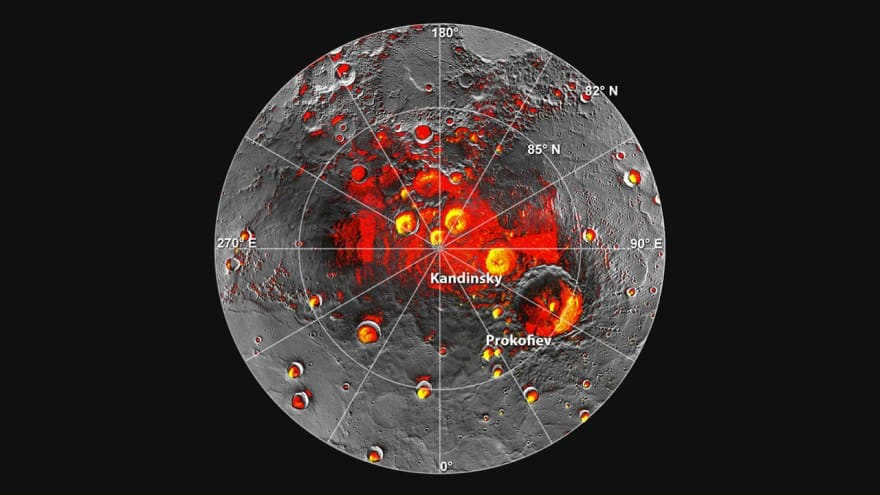
The MESSENGER spacecraft captured the North Pole of the planet. The areas in red indicate shaded areas, while the yellow areas represent ice.
Due to the lack of an atmospheric layer, Mercury experiences significant temperature fluctuations. On the sunny side, temperatures can reach 427 degrees Celsius, while on the dark side, temperatures drop to -173 degrees Celsius.
In spite of these extreme temperatures, the surface of Mercury contains water ice and organic molecules. This can be attributed to the depth of the pole craters, which prevent direct sunlight from reaching these areas. It is estimated that there may be 10^14 to 10^15 kilograms of ice at the bottom of these craters. The origin of this ice on the planet is not yet definitively known, but it is possible that it came from comets or from the release of water from the planet’s interior.
A history of exploration accompanies the description of Mercury. This planet has been observed for centuries and has even appeared in myths and ancient legends. The earliest records of Mercury can be found in the Moul Apin tablet, which served as astronomical and astrological Babylonian records.
These observations date back to the 14th century BC and describe Mercury as a “dancing planet” due to its fast movements. In ancient Greece, it was known as Stilbon, meaning “shine,” and was considered the messenger of Olympus. The Romans later adopted this concept and gave the planet its modern name in honor of their pantheon.
Ptolemy, in his works, mentioned the ability of planets to pass in front of the Sun. However, he did not provide examples of Mercury and Venus as he deemed them too small and inconspicuous.
The Chinese referred to it as Chen Xin (“Clock Star”) and associated it with water and the northern direction. The Asian culture still holds such a belief about the planet, which is even classified as the 5th element.
For the Germanic tribes, there was a connection with the god Odin. The Mayans observed four owls, with two responsible for the morning and the other two for the evening.
The geocentric orbital path was documented as early as the 11th century by an Islamic astronomer. In the 12th century, Ibn Bajya observed the passage of two small dark objects in front of the Sun. It is likely that he saw Venus and Mercury.
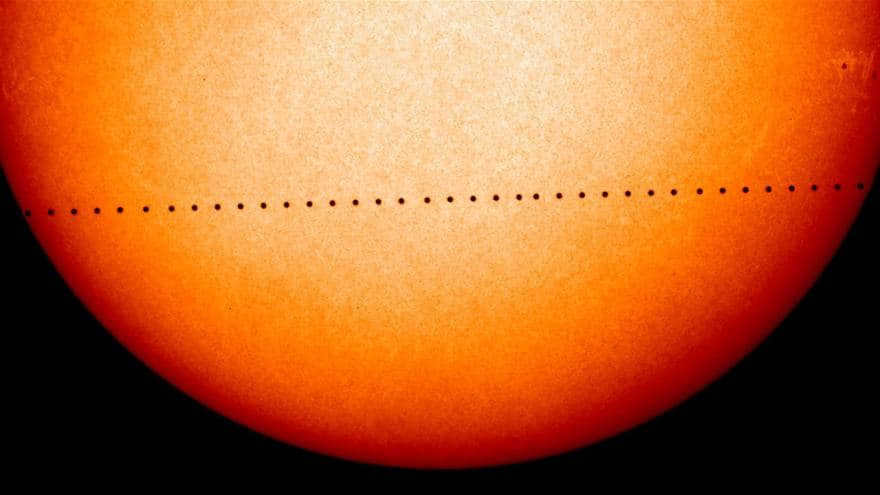
Mercury’s passage across the solar disk was witnessed by SOHO in 2006. The transit was visible in Eastern Europe and the Eastern Hemisphere
In the 15th century, the Indian astronomer Somayaji of Kerala developed a heliocentric model that involved Mercury orbiting the Sun.
The first recorded observation of Mercury through a telescope was made in the 17th century by Galileo Galilei, who was studying the phases of Venus at the time. However, his telescope lacked sufficient power to observe Mercury in detail. It was not until 1631 that the transit of Mercury was officially noted by Pierre Gassendi.
In 1639, Giovanni Zupi observed the orbital phases of Mercury, providing further evidence for its rotation around the Sun and confirming the accuracy of the heliocentric model.
Giovanni Schiaparelli made more precise observations in the 1880s, determining that the orbital period of Mercury was 88 days. In 1934, Eugios Antoniadi produced an elaborate map showcasing the surface of the planet.
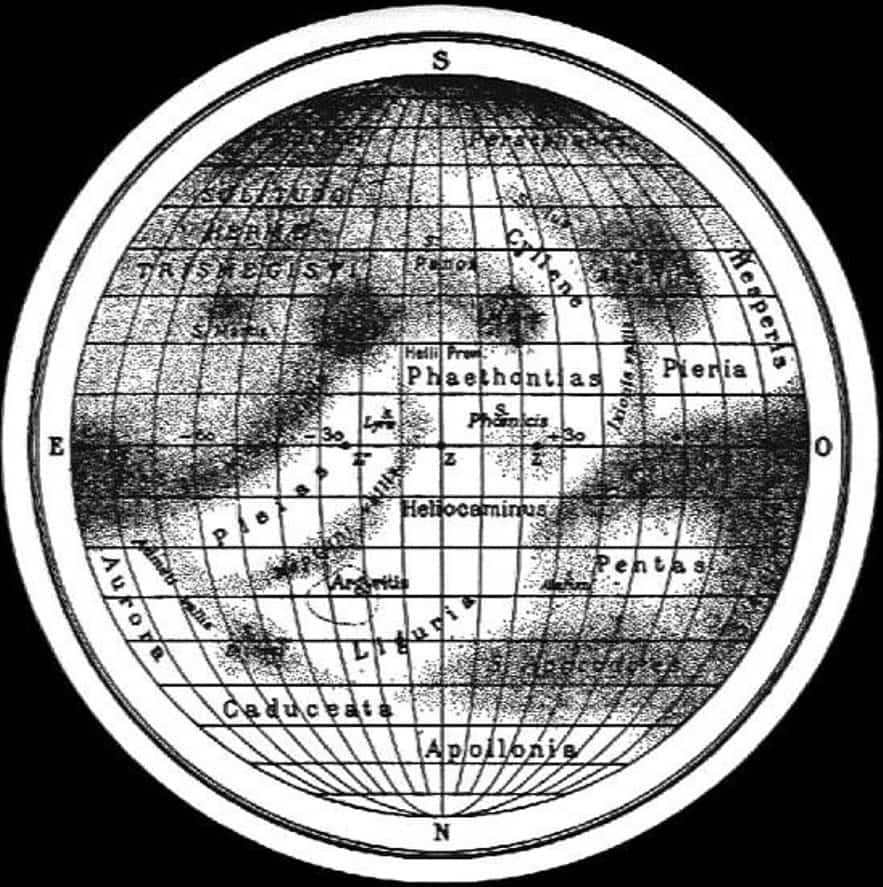
A map of Mercury, created by Antoniadi, has been produced.
In 1962, Soviet scientists successfully repelled the initial radar signal, while three years later, the Americans replicated the experiment and determined an axial rotation of 59 days. Traditional optical observations failed to yield new findings, but interferometers revealed the chemical and physical properties of the subsurface.
The Mount Wilson Observatory conducted the first comprehensive examination of surface features in 2000. The majority of the map was generated using the Arecibo Radar Telescope, which has a range of up to 5 kilometers.
Discovering the world
Prior to the initial unmanned expedition, our understanding of the morphological attributes was limited. The first spacecraft to venture to Mercury was Mariner in 1974-1975. It made three close approaches and captured a collection of extensive photographs.
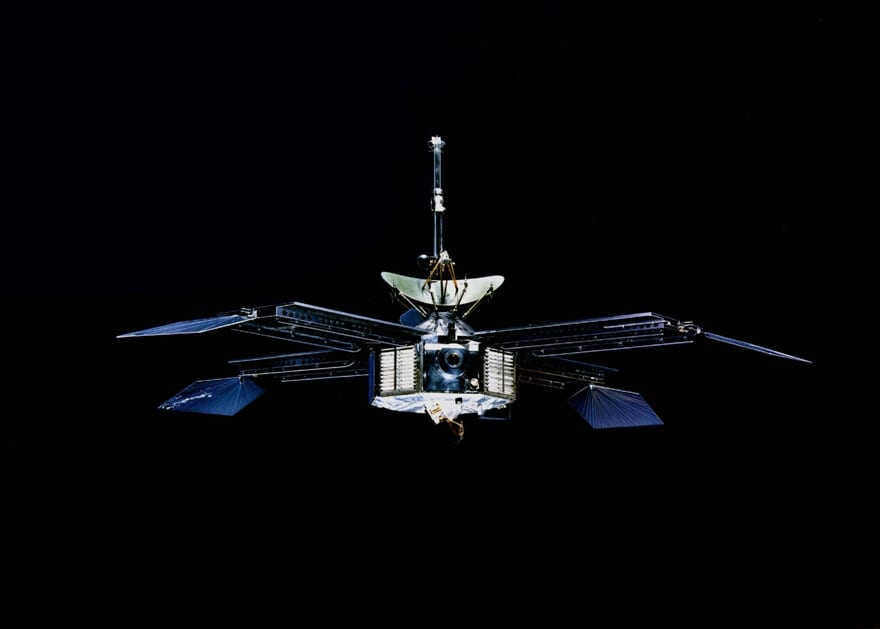
The Mariner 10 spacecraft, operated by NASA, conducted explorations of Venus and Mercury during the 1970s.
However, due to its lengthy orbital period, the spacecraft approached the same side on each approach, resulting in a map that covered only 45% of the total area.
During its initial approach, Mariner 10 was able to detect a magnetic field, which subsequent approaches revealed to be similar to Earth’s magnetic field in its ability to deflect stellar winds.
In 1975, the spacecraft depleted its fuel and communication was lost. Nevertheless, Mariner 10 continues to orbit the Sun and make visits to Mercury.
The MESSENGER spacecraft served as the second messenger in exploring Mercury. It was equipped with cameras capable of capturing high-resolution images and spectrometers designed to analyze the composition of the planet, including density, magnetic field, geology, core structure, and atmospheric features.
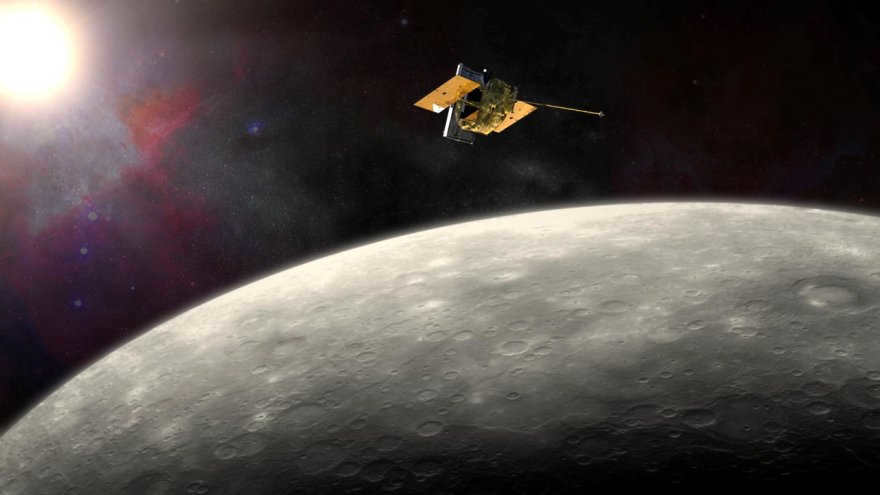
The MESSENGER spacecraft has been in orbit around Mercury since March 2011.
Having been launched in 2004, MESSENGER has completed three flybys since 2008, compensating for the areas not covered by Mariner 10. In 2011, it transitioned into an elliptical planetary orbit and began capturing images of the surface.
Following this, the next one-year mission was launched. The final maneuver occurred on April 24, 2015. Subsequently, the satellite ran out of fuel and crashed into the surface on April 30.
In 2016, ESA and JAXA collaborated to develop BepiColombo, which is expected to reach the planet in 2024. This mission consists of two probes that will investigate the magnetosphere and the surface using various wavelengths.
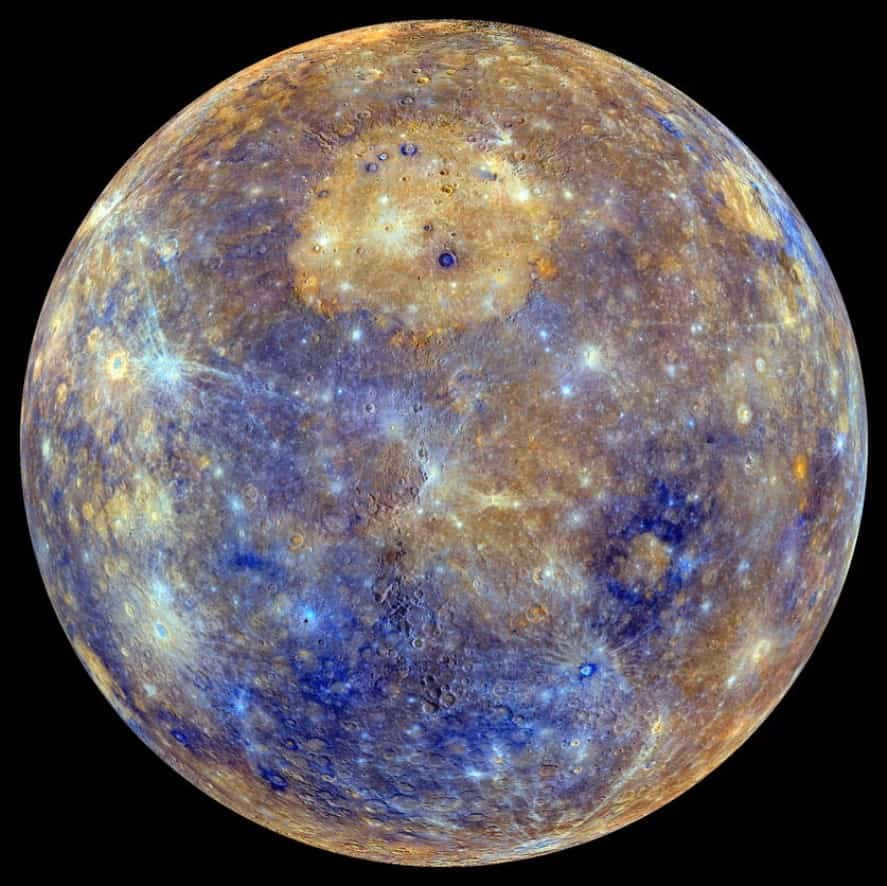
An enlarged depiction of Mercury produced from images captured by the MESSENGER camera
Mercury is a fascinating celestial body characterized by a mixture of extremes and contradictions. It features a molten terrain as well as icy regions, lacks an atmosphere, yet possesses a magnetosphere. The advancements in technology hold the promise of uncovering more captivating intricacies about this planet. Make sure to explore the modern high-resolution map showcasing the surface of Mercury.
Map of the Surface
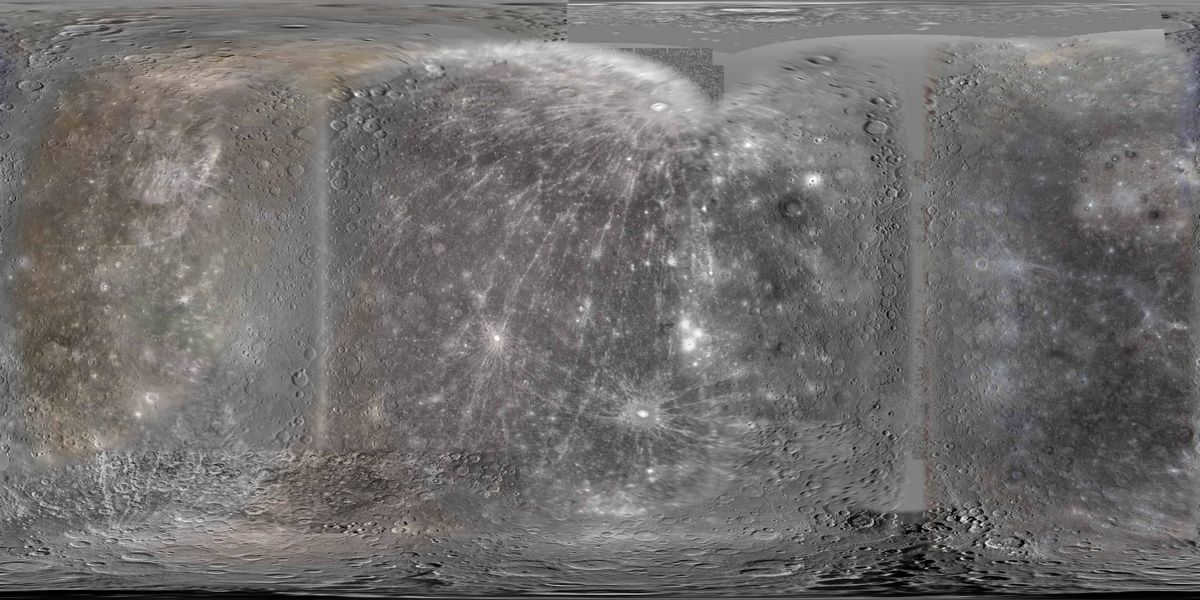
Click the image to enlarge it
Ancient civilizations believed that Mercury was the swiftest planet, which is why it was named after the messenger of the gods. Upon closer examination, scientists discovered that its rapid motion was a result of its proximity to the sun.
However, this planet is also remarkable for its extreme temperature conditions. It endures scorching heat and frigid cold simultaneously. Unlike Earth, Mercury has a nearly non-existent atmosphere. To truly comprehend its unique characteristics, let’s compare it to our own home planet.
Mercury has a diameter of 4879 km, which is only 38% of the diameter of Earth. It’s amazing to think that you could fit three Mercuries within the boundaries of our planet.
A Comparison of Earth and Mercury
Mercury has a mass of 3.3 x 1023 kg, which is 5.5% of Earth’s mass. It is also the second densest planet, with a density of 5.427 g/cm3. The surface gravity on Mercury is 3.7 m/s2, which is 38% of Earth’s gravity. So if you weigh 100 kg here, you would only weigh 38 kg on Mercury.
The surface area of Mercury is 75 million km2, which is 10% of Earth’s surface area. If you could somehow turn the planet around, it would be twice the size of Asia. The volume of Mercury is 6.1 x 1010 km3, which is 5.4% of Earth’s volume. You could fit 18 Mercuries within Earth’s volume and still have some space left over.
While our planet takes 365.25 days to complete an orbit around the sun, Mercury only takes 87.969 days.
The length of a single axial rotation on Mercury is 58.646 days, whereas it takes the Sun 176 days to complete a full pass across the sky. This means that one day on Mercury is twice as long as a year. Additionally, Mercury is tilted at an angle of 0.027° (compared to Earth’s angle of 23.439°), making it the smallest tilt in the solar system.
Composition and structure
This planet is similar to Earth in terms of its composition, consisting of silicate minerals and metals. However, unlike Earth which is predominantly silicate, Mercury is comprised of 70% metallic materials.
Mercury’s core is made up of molten iron, surrounded by a mantle of silicate. While Earth has a thicker core and mantle (3478 km and 2800 km compared to Mercury’s 1800 km and 600 km), Mercury’s crust is thicker (100 km compared to Earth’s 100-300 km). Additionally, the core of Mercury makes up 42% of its total volume, whereas Earth’s core only accounts for 17%.
Mercury’s internal structure consists of a crust (100-300 km), mantle (600 km), and core (1800 km).
When it comes to the surface, Mercury resembles a satellite of Earth. It is a dry desert with numerous impact craters, which have remained unchanged for billions of years. These craters can range in size from tiny to enormous and were formed during asteroid impacts that occurred over 4.6 billion years ago.
The Heat Plain is known for its immense size, measuring 1550 km in diameter. The impact of this phenomenon was so powerful that it triggered the activation of a volcano on the opposite side, resulting in the formation of a 2 km high ring around the crater.
An enhanced view of the Munch, Sander, and Poe craters near the Heat Plain.
The Earth’s surface exhibits a wide variety of landscapes, including mountains, plains, continents, and oceans. It is also home to deserts, gorges, volcanoes, and plateaus.
Mercury provides evidence that it too was once active. This is shown through the presence of narrow ridges that stretch for hundreds of kilometers. It is believed that these ridges formed when the planet underwent a process of shrinking. However, while things may have quieted down on Mercury, the Earth continues to be active. The movement of tectonic plates leads to periodic volcanic eruptions and earthquakes.
Atmosphere and temperature
In terms of atmosphere and temperature, the two planets are completely different. Earth has a robust atmosphere with multiple layers, consisting mainly of nitrogen and oxygen.
The MESSENGER spectrometer documented the process of solar wind pushing particles from Mercury’s surface into its thin atmosphere.
Earth’s average temperature is 14°C, with a maximum of 70.7°C and a minimum of -89.2°C. On the other hand, Mercury only has a tenuous exosphere that fails to retain heat. Considering the pressure of 10-14 bar, the sunny side of Mercury heats up to a scorching 427°C, while the temperature on the night side plummets to -173°C.
Interestingly, despite these extreme temperature variations, water ice manages to survive at the poles. This is because it is hidden in the depths of craters where direct sunlight cannot reach.
Mercury’s core generates a relatively weak magnetic field, accounting for only 1.1% of Earth’s magnetic field strength. It is believed that the mechanism behind its formation is similar to the dynamo effect observed on our planet. Nevertheless, this magnetic field is sufficient to counteract the solar wind and create a magnetosphere around Mercury. The magnetosphere helps to shield the planet’s surface from the impact of the solar wind, which gradually erodes the outer layers of the planet.
The Structure of Mercury’s Magnetic Field
It is worth noting the stark differences between Earth and Mercury. Despite being smaller and less massive, Mercury has a comparable density to our planet. However, the extreme temperatures on Mercury make it inhospitable for human exploration. Despite these challenges, further research and exploration of Mercury are still on the horizon.
The Position and Movement of Mercury
Mercury: The Closest Planet to the Sun
About Mercury
Mercury is the closest planet to the Sun in our solar system. It is named after the god Mercury, who was known as the messenger of the gods and the patron of trade and travelers. This name is fitting because Mercury has the highest speed of rotation around the Sun compared to all the other planets. It moves at an incredible speed of 174,000 km/h.
Orbit and Distance
Mercury has an elongated orbit around the Sun and completes a full revolution in 88 Earth days (or 87.97 to be precise). At its furthest point from the Sun, it is about 70 million km away, while its shortest distance is only 46 million km.
Rotation
One interesting fact about Mercury is that it has a longer stellar day compared to its year. It takes 58.65 Earth days for Mercury to complete one revolution around its axis, while it completes one and a half revolutions in a Mercurian year.
The mean duration between the two successive upper culminations of the Sun on this celestial body is 176 days. It is worth noting that during its proximity to perihelion (the point of its orbit closest to the Sun), the Sun can appear to move in the opposite direction for a span of 8 days, as observed from the planet’s surface.
The distance from Earth to Mercury ranges from 82 to 217 million kilometers. This celestial body is visible to the naked eye. Over the course of a few days, when observed from Earth, Mercury undergoes a change in its position relative to the Sun, transitioning from west (morning visibility) to east (evening visibility). The axis of rotation of Mercury and its orbit are almost perpendicular to each other. Mercury is of such small size that its mass (3.3-1023 kg) is only 1/20th that of Earth. Its radius measures a mere 2439.7 ± 1.0 km, making it smaller than the radius of Jupiter’s moon Ganymede and Saturn’s moon Titan. Due to its proximity to the Sun, the planet’s relatively slow rotation, and its exceedingly thin atmosphere, Mercury experiences the most extreme temperature fluctuations in the entire Solar System. On the sunlit side of the planet, temperatures reach 420°C, while on the dark side they plummet to -190°C. The average density of Mercury is 5.43 g/cm³, slightly lower than that of Earth, suggesting a high concentration of metals in its interior. The planet possesses an almost perfectly spherical shape. The acceleration of free fall on its surface amounts to g = 3.72 m/s².
Video Content
Mercury
Mercury is the smallest planet in the solar system. It orbits the sun at a high velocity.
The majority of our knowledge about this celestial body comes from the Mariner 10 spacecraft, which was sent to explore Mercury in 1974. It remains the only mission dedicated to studying the planet.
The photographs taken by Mariner 10 revealed a surface covered in craters. At first glance, Mercury’s terrain appears similar to that of the Moon, with its lunar plateaus and plains. These features bring to mind the seas found on our own planet’s natural satellite.
On a smooth planet, formations called smooth spaces appeared. It is believed that these spaces were created when hot rocks were ejected from the planet’s interior. Mercury’s landscape is predominantly characterized by large ledges. These ledges span hundreds of kilometers and vary in height from a few hundred meters to a maximum of 3km. The formation of these geological structures can be attributed to the fracturing of the planet’s crust, which occurred as a result of rapid cooling and subsequent warming. These events took place during the formation of Mercury.
Mercury’s magnetic field is relatively weak compared to that of Earth, with a strength that is only 1/100th as powerful. The crust and mantle of the planet are quite thin, similar to Earth’s. The density of Mercury is also high, exceeding 5g/cm3, which suggests that it is primarily composed of heavy elements. Scientists believe that approximately 70% of the planet’s mass is made up of an iron core, which occupies about three-quarters of its radius. This iron core is responsible for generating the magnetic field, although the exact process by which it occurs is not fully understood. One possibility is that the molten metal inside the core acts as a DC generator, similar to what happens in Earth’s interior. It is unlikely that Mercury has had such a large iron core since its formation, as it is more probable that a significant portion of the mantle broke away during a catastrophic collision with another celestial body that occurred early in the formation of the solar system.
Because Mercury is located between the Earth and the Sun, its phases share many similarities with the phases of the Moon. When it is closest to Earth, it appears as a thin crescent, while at its farthest point from our planet, most of its surface is well illuminated. Due to its close proximity to the Sun, it is practically impossible to observe Mercury in its full phase. This is because Mercury’s orbit is inclined 7 degrees to the plane of the Earth, causing it to be deflected to the north or south of the Sun during its passage between the Sun and the Earth. Approximately once every hundred years, Mercury transits in front of the Sun, an event known as a “transit”.
Mercury has an extremely slow rotation speed on its own axis. Throughout its entire orbit around the Sun, Mercury completes only one and a half rotations around its axis. A solar day on the planet, which refers to the period from one sunrise to the next, is equivalent to two Mercurian years.
Because Mercury rotates very slowly on its axis, one hemisphere of the planet is constantly facing the Sun for extended periods of time. As a result, the difference between day and night on Mercury is much less pronounced compared to other planets in our solar system. During the night on the hemisphere opposite the Sun, the temperature drops to a bone-chilling -180 degrees Celsius. However, when Mercury is at its farthest point from the Sun, known as aphelion, temperatures can rise to a scorching +430 degrees Celsius in the “afternoon.” Due to the fact that Mercury’s axis of rotation is nearly perpendicular to the plane of its orbit, the planet does not experience seasons like Earth does. Additionally, there are areas near the poles where sunlight never reaches.
Venus, the second planet from the Sun and the closest one to Earth, is known for being the brightest celestial body in the sky, following the Sun and the Moon. Its luminosity is particularly noticeable during dawn and dusk. Although the existence of Venus has been known since ancient times, it was Galileo who made the groundbreaking discovery of its phases through the use of a telescope. The initial observations made through this instrument also revealed the presence of towering mountains on the planet’s surface.
The history of the Earth, as well as that of the entire solar system, spans approximately 4.5 billion years. Throughout its evolution, our planet has undergone a complex and extensive journey. During its early stages, the Earth existed in a molten state due to the extremely high temperatures. This explains the presence of heavy elements such as iron and nickel in the planet’s core, which are characterized by their high density.
Secrets of Mercury: Fascinating Discoveries
Each planet within our solar system holds its own mysteries and enigmas. However, as humanity progresses, our understanding of the universe expands at an exponential rate. With advancements in technology, our access to the celestial bodies within our system grows ever closer. Initially, we focused on the planets nearest to us, but with the launch of numerous space stations, our gaze has shifted to the farthest reaches of our solar system. Yet, there exists a hidden planet amidst the familiar celestial bodies. Due to its close proximity to our radiant sun, observing it has proven to be a challenging feat. It remains concealed within the sun’s brilliant rays. This elusive planet is none other than Mercury.
The ancient Romans regarded Mercury as the patron saint of commerce, travelers, and thieves, as well as the divine messenger. It is no wonder that a swift-moving small planet that trails the Sun in the sky was named after him. Mercury has been known since ancient times, but early astronomers were not immediately aware that they were observing the same celestial body in both the morning and evening. In Greek mythology, it corresponds to the god Hermes, the divine messenger. Perhaps the planet acquired its name due to its rapid motion across the heavens.
Mercury’s diminutive size and its perpetual proximity to the Sun make it a challenging subject for study from Earth. Occasionally (approximately ten times per century), Mercury transits directly between the Earth and the Sun. During such occurrences, a minuscule dot can be discerned against the backdrop of the Sun’s surface.
Mercury, the planet closest to the Sun, has an average distance of only 58 million kilometers from it.
Mercury has a small mass, only 0.06 times that of the Earth. It has a diameter of 4880 km, making it slightly larger than the Moon. However, there are several moons in our Solar System that are even larger than Mercury, including two of Jupiter’s moons, one of Saturn’s moons, and one of Neptune’s moons. Mercury’s orbit has a high inclination of 7° compared to the ecliptic, making it one of the largest in our Solar System. The planet’s axis is almost perpendicular to its orbit, which is highly elongated. Mercury and Earth have a similar density of matter, approximately 5500 kg/m3. This density, along with the planet’s size, determines its gravitational force. Mercury’s gravitational force is three times less than that of Earth but twice as much as that of the Moon.
Mercury is commonly regarded as the planet that is closest to the Sun. But why is it only “considered” as such? The reason lies in its irregular movement, which seems to be influenced by an external force. This has led to speculation about the existence of another planet that is even closer to the Sun. This hypothetical planet has been casually named Vulcan. However, the peculiar motion of Mercury was eventually explained by the general theory of relativity. Interestingly, even this theory is now facing some doubts and scrutiny. Scientists have recently demonstrated the existence of particles that can travel at speeds greater than that of light.
Observing Mercury can be done with the naked eye, but it is only visible during certain times of the day – either before sunrise or after sunset. This is why ancient astronomers mistakenly believed that they were observing two separate stars.
Due to its positioning between the Earth and the Sun, Mercury exhibits phases that are similar to those of the Moon.
The enigmatic connection between Mercury and Earth could potentially be elucidated as a result of the upcoming encounter with the Messenger probe.
When the Messenger probe passes near Mercury, one of the most enigmatic planets in the solar system, it may provide valuable insights into the inexplicable bond it shares with Earth.
On January 14, 2008, at 22:04 Moscow time, NASA’s Messenger research probe made its first close approach to Mercury. The probe will come within approximately 200 km of the planet’s surface, offering a unique opportunity to gather data on this poorly understood celestial body.
Over the course of the mission, the probe will have two more encounters with Mercury in October 2008 and September 2009, during which it will execute perturbation maneuvers to study the planet’s gravitational field. Finally, in March 2011, the probe will enter orbit around Mercury, commencing a comprehensive and systematic investigation. The orbital phase of the mission is planned to last for one year.
So far, the only close-up images of the planet have been obtained from the flyby of Mariner 10 near Mercury on March 16, 1975. Mercury, which is relatively unexplored, is the only planet in the Solar System that does not yet have a comprehensive map of its surface, just like Pluto. This lack of knowledge makes it highly likely that there will be unexpected discoveries awaiting scientists when they get a closer look.
One of the most enigmatic characteristics of Mercury is its peculiar and currently unexplained resonance relationship of orbits (with a duration of 116 Earth days). Efforts to elucidate this correlation through gravitational (tidal) interaction among the planets, as Dr. Leonid Xanfomaliti points out in his book “Parade of Planets”, “have yielded little success” – the magnitude of such interaction is 1.6 million times weaker than the tidal effect of the Sun and more than five times weaker than the influence of Venus, which is in closer proximity to Mercury. The enigma of how to account for the genuine connection between Earth and Mercury remains entirely unclear.
Strictly speaking, the correlation can be “explained” by a combination of traditionalist beliefs, which posit the existence of a “non-physical” link between the earthly and celestial realms. However, from a modern scientific perspective, these “explanations” do not hold up to scrutiny. Nevertheless, there are no other “suitable” explanations available at present.
The resonant connection between the orbits of Earth and Mercury is evident in the fact that the latter – from the perspective of an Earth observer – completes four orbits around the Sun in the span of one Earth year, while also completing three rotations around its own axis.
As of the time of writing this article, NASA has not yet released any images of the enigmatic planet taken by the Messenger probe. These images will be made available at a later date on the Research and Development – R&D.CNews portal.
Alignment of Mercury, Earth, and the Sun on May 9th
Witness a rare event as Mercury transits between Earth and the Sun
On May 9th, astronomers will have the opportunity to observe a rare event known as the transit of Mercury, where the small planet in our solar system will pass directly between Earth and the Sun. The last occurrence of this event took place in 2006, and the next two transits will be visible in 2019 and 2032. During the transit, which will take place in the afternoon, Mercury will appear as a dark silhouette against the bright surface of the Sun.
The transit will be well observed in a number of regions, including western and eastern Europe, western North and West Africa, eastern North America, and most of South America. It will also be visible to a certain extent in other parts of North and South America, the eastern Pacific, Africa, and Asia. However, observers in East Asia, Southeast Asia, and Australia will not have the opportunity to see the phenomenon.
Additionally, this rare event can be observed in most regions of Russia, with the exception of the southeast of Amur Region, the south of Khabarovsk Krai, Primorsky Krai, and Sakhalin Region.
Mercury orbits the Sun in a span of 88 days, making it pass between the Earth and the Sun every 116 days. Due to the tilt of Mercury’s orbit compared to the Earth’s, the planet tends to cross the path of our star either above or below it. A transit can only happen when Earth, Mercury, and the Sun align in three dimensions.
You can witness this extraordinary event through the Sun Online Space Observatory as well.
Mercury (planet) – Cyril and Methodius Mega-Encyclopedia – Article
Mercury is a planet that is located at a mean distance of 0.387 astronomical units (58 million km) from the Sun. It has a rotation period of 88 days and a revolution period of 58.6 days. With an average diameter of 4878 km and a mass of 3.3 x 10^23 kg, Mercury has an extremely rarefied atmosphere consisting of Ar, Ne, and He. The surface of Mercury bears a striking resemblance to that of the Moon.
The orbital period of Mercury around its axis is 58.6461 ± 0.0005 days, which is two-thirds of its orbital period around the Sun. This phenomenon is caused by tidal friction and the gravitational forces exerted by the Sun, as the distribution of masses on Mercury is not perfectly concentric (the center of mass is displaced from the geometric center of the planet). The combination of Mercury’s orbit around the Sun and its rotation results in the duration of a solar day on the planet being equivalent to three Mercurian stellar days or two Mercurian years, which is approximately 175.92 Earth days.
Mercury has a tilt in its axis of rotation of less than 3° relative to the plane of its orbit, which means that there are no significant seasonal changes on this planet. Observing Mercury from Earth is challenging because it never appears to move more than 28° away from the Sun, so it is always seen against the backdrop of the evening or morning sky just above the horizon. Additionally, during this time, the phase of the planet (the angle between the directions to the Sun and Earth) is close to 90°, resulting in only half of its disk being illuminated.
Mercury is nearly spherical in shape, with an equatorial radius of (2440 ± 2) km, making it about 2.6 times smaller than Earth. The difference in the semi-major axis of Mercury’s equatorial ellipse is approximately 1 km, and there is little variation in its equatorial and polar compressions. The geometric center of the planet deviates from the center of mass by about one and a half kilometers. Mercury’s surface area is 6.8 times smaller than Earth’s, and its volume is 17.8 times smaller.
Mercury has a mass of 3.31 × 10^23 kg, which is around 18 times less than Earth’s mass. Its average density is similar to Earth’s at 5.44 g/cm3. The free fall acceleration near Mercury’s surface is 3.7 m/s2.
Being the planet closest to the Sun, Mercury receives a much higher amount of energy from the central star than Earth does (on average, by a factor of 10). The energy flux from the Sun varies by about two due to Mercury’s elongated orbit. The long periods of daylight and darkness result in significant differences in brightness temperatures (measured using infrared radiation based on Planck’s law of thermal radiation) between the “day” and “night” sides of Mercury’s surface at an average distance from the Sun, ranging from about 600 K to 100 K. However, at depths of several tens of centimeters, there are no significant temperature fluctuations, thanks to the very low thermal conductivity of the rocks.

